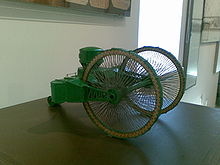- Tsar Tank
-
Tsar Tank Place of origin  Russian Empire
Russian EmpireService history In service 1914-1915 (experimental) Used by Russian Empire The Tsar Tank (Russian: Царь-танк), also known as the Netopyr' (Нетопырь) which stands for pipistrellus (a bat, Летучая мышь) or Lebedenko Tank (танк Лебеденко), was an unusual Russian armoured vehicle developed by Nikolai Lebedenko (Николай Лебеденко), Nikolai Zhukovsky (Николай Жуковский), Boris Stechkin (Борис Стечкин), and Alexander Mikulin (Александер Микулин). The project was scrapped after initial tests deemed the vehicle to be underpowered and vulnerable to artillery fire.
It differed from modern tanks in that it did not use caterpillar tracks—rather, it used a tricycle design. The two front spoked wheels were nearly 9 metres (27 feet) in diameter; the back wheel was smaller, only 1.5 metres (5 feet) high, triple wheel, to ensure maneuverability. The upper cannon turret reached nearly 8 metres high. The hull was 12 metres wide with two more cannons in the sponsons. Additional weapons were also planned under the belly. Each wheel was powered by a 250 hp (190 kW) Sunbeam engine.[1]
The vehicle received its nickname because its model, when carried by the back wheel, resembled a bat hanging asleep.
The huge wheels were intended to cross significant obstacles. However, due to miscalculations of the weight, the back wheel was prone to be stuck in soft ground and ditches, and the front wheels were sometimes insufficient to pull it out. This led to a fiasco of tests before the high commission in August 1915. The tank remained in the location where it was tested, some 60 kilometres from Moscow until 1923 when it was finally taken apart for scrap.
See also
References
External links
- http://www.landships.freeservers.com/lebedenko_info.htm
- http://web.archive.org/web/20080419052234/panzermodelkit.valka.cz/lebedaj.htm
Russian "Tsar" projects - Tsar Bell
- Tsar Bomba
- Tsar Cannon
- Tsar Tank
- List
- Category
British - Mks I, II, III
- Mk IV
- Mk V
- Mk VI
- Mark VII
- Mk VIII
- Mk IX
- Medium Mk A "Whippet"
- Medium Mk B
- Medium Mk C
- Little Willie
- Flying Elephant
- Killen-Strait Amoured Tractor
- Lancelot De Mole's proposal* (1912)
French - Schneider CA1
- St Chamond
- Renault FT-17
- Breton-Prétot machine
- Boirault machine
- Frot-Laffly landship
- Souain prototype
- Levavasseur* (1903)
German Austrian - Günther Burstyn's Motorgeschütz* (1911)
Italian American - Holt Gas-Electric
- Skeleton tank
- Steam tank
- Steam Wheel Tank
- Three-wheeled steam tank
Russian - Tsar Tank
- Vezdekhod
- Mendeleev Tank*
- Rybinsk tank*
Categories:- Tanks of Russia
- World War I tanks of Russia
- Russian inventions
- Trial and research tanks
Wikimedia Foundation. 2010.


